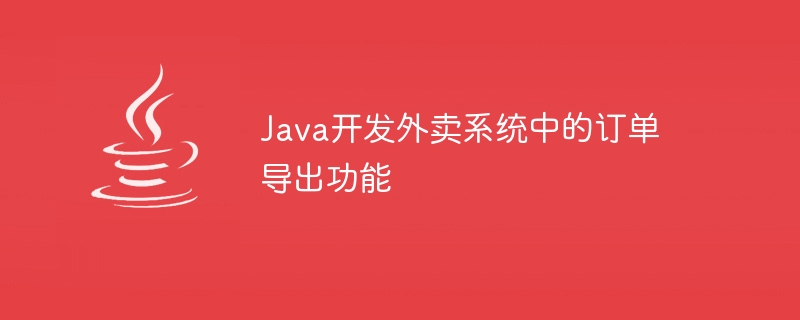

With the rapid development of Internet technology, the food delivery industry has risen rapidly. More and more people are choosing to order takeout at home to enjoy convenient meals. In order to improve the efficiency and user experience of the food delivery industry, many food delivery platforms use Java to develop food delivery systems, of which the order export function is a very important part. This article will introduce the order export function in the Java development takeout system.
Order export refers to exporting order data in the takeout system into Excel files or other formats to facilitate data analysis and management by merchants. The order export function not only helps merchants better understand their business conditions, but also provides corresponding reports and statistical data so that merchants can formulate more effective business strategies.
Java is a programming language widely used in enterprise-level application development. It has a wealth of development tools and libraries, making it more convenient and flexible to develop the order export function in the takeout system.
In developing the order export function in the Java takeout system, you first need to realize the reading and storage of order data. The system needs to be able to record relevant information about user orders in a timely manner, such as order number, order time, user information, product information, order status, etc. A database can be used to store order data, such as a relational database such as MySQL or Oracle. In Java, you can use JDBC or ORM framework such as Hibernate to interact with the database to read and store order data.
Next, you need to export the order data to an Excel file. Java provides a POI library that can easily operate Excel files. You can use the API in the POI library to create Excel files, add order data, set cell formats, etc. An Excel file can be generated through Java code and the order data can be written into the file. Merchants can filter and sort order data according to their own needs, and then export it to Excel files to facilitate their own data analysis and report production.
In addition to exporting to Excel files, the order export function in the Java development takeout system can also support other common file formats, such as CSV, PDF, etc. For CSV format, it can be implemented using file read and write operations in Java. For PDF format, IText library can be used to generate PDF files. Merchants can choose the appropriate file format to export orders according to their own needs.
The order export function can also support time range filtering. Merchants can select a specific time range to export order data according to their own needs. For example, merchants can filter order data based on a certain month or quarter, and then export the order data during this period to an Excel file.
In addition, in order to enhance the usability of the order export function, you can consider providing scheduled tasks for order export for merchants. Merchants can set up scheduled tasks to automatically export order data at fixed time points every day or every week. In this way, the merchant does not need to do manual operations, and the system will automatically export the order data to a file.
To sum up, the order export function in Java development of takeout system is a very important part. Through Java's rich tools and libraries, order data can be easily read and stored, and order data can be exported to Excel, CSV, PDF and other file formats. The order export function can help merchants conduct data analysis and management, and improve the efficiency and user experience of the takeout system. At the same time, in order to enhance the usability of the function, you can consider adding the function of scheduled tasks to automatically export order data.
The above is the detailed content of Java develops the order export function in the takeout system. For more information, please follow other related articles on the PHP Chinese website!




